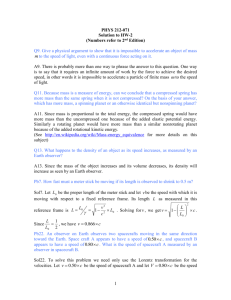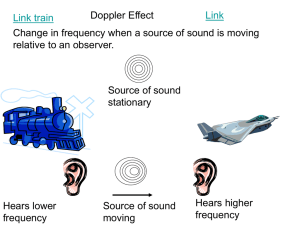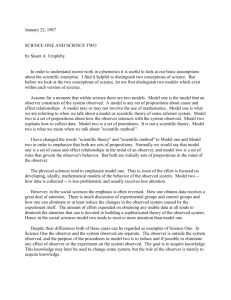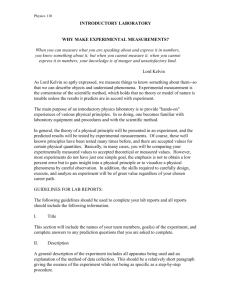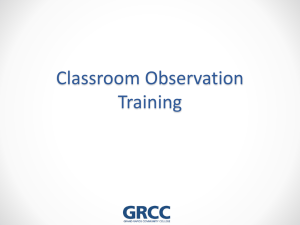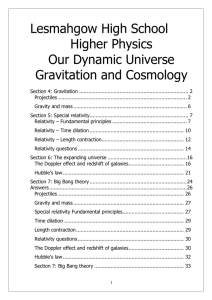Relativity Calculations 2 Solution
advertisement
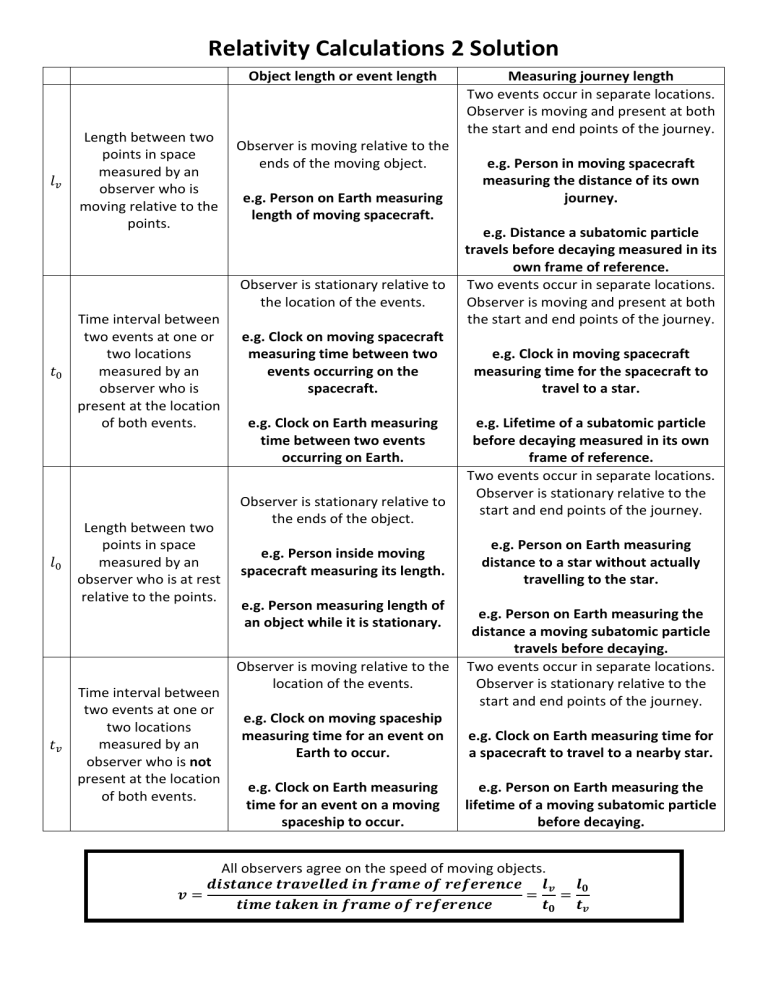
Relativity Calculations 2 Solution Object length or event length 𝑙𝑣 Length between two points in space measured by an observer who is moving relative to the points. Observer is moving relative to the ends of the moving object. e.g. Person on Earth measuring length of moving spacecraft. Observer is stationary relative to the location of the events. 𝑡0 𝑙0 𝑡𝑣 Time interval between two events at one or two locations measured by an observer who is present at the location of both events. Length between two points in space measured by an observer who is at rest relative to the points. Time interval between two events at one or two locations measured by an observer who is not present at the location of both events. e.g. Clock on moving spacecraft measuring time between two events occurring on the spacecraft. e.g. Clock on Earth measuring time between two events occurring on Earth. Observer is stationary relative to the ends of the object. e.g. Person inside moving spacecraft measuring its length. e.g. Person measuring length of an object while it is stationary. Observer is moving relative to the location of the events. Measuring journey length Two events occur in separate locations. Observer is moving and present at both the start and end points of the journey. e.g. Person in moving spacecraft measuring the distance of its own journey. e.g. Distance a subatomic particle travels before decaying measured in its own frame of reference. Two events occur in separate locations. Observer is moving and present at both the start and end points of the journey. e.g. Clock in moving spacecraft measuring time for the spacecraft to travel to a star. e.g. Lifetime of a subatomic particle before decaying measured in its own frame of reference. Two events occur in separate locations. Observer is stationary relative to the start and end points of the journey. e.g. Person on Earth measuring distance to a star without actually travelling to the star. e.g. Person on Earth measuring the distance a moving subatomic particle travels before decaying. Two events occur in separate locations. Observer is stationary relative to the start and end points of the journey. e.g. Clock on moving spaceship measuring time for an event on Earth to occur. e.g. Clock on Earth measuring time for a spacecraft to travel to a nearby star. e.g. Clock on Earth measuring time for an event on a moving spaceship to occur. e.g. Person on Earth measuring the lifetime of a moving subatomic particle before decaying. All observers agree on the speed of moving objects. 𝒅𝒊𝒔𝒕𝒂𝒏𝒄𝒆 𝒕𝒓𝒂𝒗𝒆𝒍𝒍𝒆𝒅 𝒊𝒏 𝒇𝒓𝒂𝒎𝒆 𝒐𝒇 𝒓𝒆𝒇𝒆𝒓𝒆𝒏𝒄𝒆 𝒍𝒗 𝒍𝟎 𝒗= = = 𝒕𝒊𝒎𝒆 𝒕𝒂𝒌𝒆𝒏 𝒊𝒏 𝒇𝒓𝒂𝒎𝒆 𝒐𝒇 𝒓𝒆𝒇𝒆𝒓𝒆𝒏𝒄𝒆 𝒕𝟎 𝒕𝒗 question knowns required 1. A spaceship at rest is measured to be 185m long. Now this spaceship flies by an observer with a speed of 0.97c. What length will the observer measure? 𝒍𝒗 = 𝒗 𝟐 𝒍𝟎 √𝟏 − ( 𝒄 ) = 𝟏𝟖𝟓√𝟏 − 𝟎. 𝟗𝟕𝟐 = 𝟒𝟓𝒎 2. An observer on Earth sees a spaceship at an altitude of 1005m moving downward toward Earth at 0.950c. What is the altitude of the spaceship as measured by an observer in the spaceship? 𝒍𝒗 = 𝒍𝟎 √𝟏 − 𝒗 𝟐 (𝒄) = 𝟏𝟎𝟎𝟓√𝟏 − 𝟎. 𝟗𝟓𝟎𝟐 = 𝟑𝟏𝟒𝒎 3. A spacecraft moves at a speed of 0.80c. If its length is 86m when measured from inside the spacecraft, what is its length measured by a ground observer? 𝒍𝒗 = 𝒍𝟎 √𝟏 − 𝒗 𝟐 (𝒄) = 𝟖𝟔√𝟏 − 𝟎. 𝟖𝟎𝟐 = 𝟓𝟐𝒎 4. A spaceship at rest is measured to be 454m long. Now this spaceship flies by an observer with a speed of 0.150c. What length will the observer measure? 𝒍𝒗 = 𝒍𝟎 √𝟏 − 𝒗 𝟐 (𝒄) = 𝟒𝟓𝟒√𝟏 − 𝟎. 𝟏𝟓𝟎𝟐 = 𝟒𝟒𝟗𝒎 5. The occupants on a spacecraft travelling at 0.45c relative to the Earth measure the time interval between two events on Earth as being 24 hours. What time interval would they measure if they were instead travelling at a speed of 0.70c with respect to the Earth? 𝒕𝟎 = 𝒕𝟎.𝟒𝟓𝒄 × √𝟏 − 𝒗 𝒕𝟎.𝟕𝟎𝒄 𝒗 𝟎.𝟒𝟓𝒄 𝟐 ( 𝒄 ) = 𝟐𝟒 × √𝟏 − 𝟎. 𝟒𝟓𝟐 = 𝟐𝟏. 𝟒𝟑𝟑𝒉𝒓 𝒕𝟎 = √𝟏 − 𝟐 (𝟎.𝟕𝟎𝒄 ) 𝒄 = 𝟐𝟏. 𝟒𝟑𝟑𝒉𝒓 √𝟏 − 𝟎. 𝟕𝟎𝟐 = 𝟑𝟎 𝒉𝒓 𝑙0 𝑙0 𝑡𝑣 𝑡𝑣 formula 2 𝑙𝑣 = 𝑙0 √1 − (𝑣𝑐) 𝑡𝑣 = 𝑡0 2 √1−(𝑣) 𝑐 𝑙𝑣 𝑙𝑣 𝑡0 𝑡0 𝑣 = 𝑡0 𝑣 𝑣 𝑣 = 𝑡𝑣 𝑙0 𝑙0 𝑡𝑣 𝑡𝑣 𝑙𝑣 = 𝑙0 √1 − (𝑣𝑐) 𝑡𝑣 = 𝑙 𝑣 𝑙 0 2 𝑡0 2 √1−(𝑣) 𝑐 𝑙𝑣 𝑙𝑣 𝑡0 𝑡0 𝑣 = 𝑡0 𝑣 𝑣 𝑣 = 𝑡𝑣 𝑙0 𝑙0 𝑡𝑣 𝑡𝑣 𝑙𝑣 = 𝑙0 √1 − (𝑣𝑐) 𝑡𝑣 = 𝑣 = 𝑡0 𝑣= 𝑙𝑣 𝑡0 𝑙𝑣 = 𝑙0 √1 − (𝑣𝑐) 𝑡𝑣 = 𝑣 = 𝑡0 𝑣= 𝑙𝑣 𝑡0 𝑙𝑣 = 𝑙0 √1 − (𝑣𝑐) 𝑡𝑣 = 𝑙𝑣 𝑙𝑣 𝑡0 𝑡0 𝑣 𝑣 𝑙0 𝑙0 𝑡𝑣 𝑡𝑣 𝑙𝑣 𝑙𝑣 𝑡0 𝑡0 𝑣 𝑣 𝑙0 𝑙0 𝑡𝑣 𝑡𝑣 𝑙 𝑣 𝑙 0 2 𝑡0 2 √1−(𝑣) 𝑐 𝑙 𝑣 2 𝑡0 2 √1−(𝑣) 𝑐 𝑙 𝑣 2 𝑡0 2 √1−(𝑣) 𝑐 𝑙𝑣 𝑙𝑣 𝑡0 𝑡0 𝑣 = 𝑡0 𝑣 𝑣 𝑣= 𝑙 𝑣 𝑙𝑣 𝑡0 6. The pi meson, an unstable particle, lives on average about 2.6x10-8s (measured in its own frame of reference) before decaying. a) If such a particle is moving with a speed of 0.60c, what lifetime is measured in the laboratory? 𝒕𝟎 𝒕𝒗 = = √𝟏 − (𝒗) 𝒄 𝟐 𝟐. 𝟔 × 𝟏𝟎−𝟖 𝒔 √𝟏 − 𝟎. 𝟔𝟎𝟐 = 𝟑. 𝟑 × 𝟏𝟎 −𝟖 𝒔 b) What distance, measured in the laboratory, does the particle move before decaying? 𝒗= 𝒍𝟎 𝒕𝒗 𝒍𝟎 = 𝒗 × 𝒕𝒗 = 𝟏. 𝟖 × 𝟏𝟎𝟖 𝒎 ⋅ 𝒔−𝟏 × 𝟑. 𝟑 × 𝟏𝟎−𝟖 𝒔 = 𝟓. 𝟗𝒎 c) What distance, measured by an observer travelling with the meson, does the particle move before decaying? 𝒗= 𝒍𝒗 𝒕𝟎 𝒍𝒗 = 𝒗 × 𝒕𝟎 = 𝟏. 𝟖 × 𝟏𝟎𝟖 𝒎 ⋅ 𝒔−𝟏 × 𝟐. 𝟔 × 𝟏𝟎−𝟖 𝒔 = 𝟒. 𝟕𝒎 d) How fast will an observer travelling with the meson compute its speed? 𝒍𝒗 𝟒. 𝟔𝟖𝒎 𝒗= = = 𝟏. 𝟖 × 𝟏𝟎𝟖 𝒎 ⋅ 𝒔−𝟏 = 𝟎. 𝟔𝒄 𝒕𝟎 𝟐. 𝟔 × 𝟏𝟎−𝟖 𝒔 Recall that all observers agree on the speed of moving objects. 𝑙0 𝑙0 𝑡𝑣 𝑡𝑣 2 𝑙𝑣 = 𝑙0 √1 − (𝑣𝑐) 𝑡𝑣 = 𝑡0 2 √1−(𝑣) 𝑐 𝑙𝑣 𝑙𝑣 𝑡0 𝑡0 𝑣 = 𝑡0 𝑣 𝑣 𝑣 = 𝑡𝑣 𝑙0 𝑙0 𝑡𝑣 𝑡𝑣 𝑙𝑣 = 𝑙0 √1 − (𝑣𝑐) 𝑡𝑣 = 𝑙 𝑣 𝑙 0 2 𝑡0 2 √1−(𝑣) 𝑐 𝑙𝑣 𝑙𝑣 𝑡0 𝑡0 𝑣 = 𝑡0 𝑣 𝑣 𝑣 = 𝑡𝑣 𝑙0 𝑙0 𝑡𝑣 𝑡𝑣 𝑙𝑣 = 𝑙0 √1 − (𝑣𝑐) 𝑡𝑣 = 𝑣 = 𝑡0 𝑣= 𝑙𝑣 𝑡0 𝑙𝑣 = 𝑙0 √1 − (𝑣𝑐) 𝑡𝑣 = 𝑣 = 𝑡0 𝑣= 𝑙𝑣 𝑡0 𝑙𝑣 = 𝑙0 √1 − (𝑣𝑐) 𝑡𝑣 = 𝑣 = 𝑡0 𝑙𝑣 𝑡0 𝑙𝑣 𝑙𝑣 𝑡0 𝑡0 𝑣 𝑣 𝑙0 𝑙0 𝑡𝑣 𝑡𝑣 𝑙𝑣 𝑙𝑣 𝑡0 𝑡0 𝑣 𝑣 𝑙0 𝑙0 𝑡𝑣 𝑡𝑣 𝑙 𝑣 𝑙 0 2 𝑡0 2 √1−(𝑣) 𝑐 𝑙 𝑣 2 𝑡0 2 √1−(𝑣) 𝑐 𝑙 𝑣 e) What speed would a clock have to be moving in order to run at 35% of the rate of a clock at rest? 𝒕𝟎 = 𝟎. 𝟑𝟓𝒕𝒗 𝒕𝟎 𝒕𝒗 = √𝟏 − 𝒕𝟎 = 𝟎. 𝟑𝟓 𝒕𝒗 𝟐 (𝒗𝒄) 𝟐 𝒕𝟎 𝒗 = √𝟏 − ( 𝒄 ) = 𝟎. 𝟑𝟓 𝒕𝒗 𝒗 𝟐 𝟏 − (𝒄) 𝒗 𝟐 = 𝟎. 𝟑𝟓𝟐 ( 𝒄 ) = 𝟏 − 𝟎. 𝟑𝟓𝟐 𝒗 𝒄 = √𝟏 − 𝟎. 𝟑𝟓𝟐 = 𝟎. 𝟗𝟒 𝒗 = 𝟎. 𝟗𝟒𝒄 In this question, “at rest” means on Earth. The other observer was originally on Earth but left in a spaceship and accelerated. It’s a twin paradox scenario. 𝑙𝑣 𝑙𝑣 𝑡0 𝑡0 𝑣 𝑣 2 𝑡0 2 √1−(𝑣) 𝑐 𝑙 𝑣 𝑣= 7. Tom drove past in his sports car at a speed of 0.85c. In your frame of reference, the moving car has a length of 0.96m and a height of 1.44m. a) What would its length and height be at rest? 𝒗 𝟐 𝒍𝒗 = 𝒍𝟎 √𝟏 − ( 𝒄 ) 𝒍𝒗 𝟏. 𝟗𝟔 𝒍𝒐 = = = 𝟑. 𝟕𝟐𝒎 𝟐 √𝟏 − 𝟎. 𝟖𝟓𝟐 𝒗 √𝟏 − ( 𝒄 ) 𝒉𝒆𝒊𝒈𝒉𝒕 𝒊𝒔 𝒖𝒏𝒄𝒉𝒂𝒏𝒈𝒆𝒅 𝒉𝒆𝒊𝒈𝒉𝒕 = 𝟏. 𝟒𝟒𝒎 b) If you held up a sign for 12s, how long would Tom say you held it up for? 𝒕𝒗 = 𝒕𝟎 √𝟏 − = 𝟐 (𝒗𝒄) 𝟏𝟐𝒔 √𝟏 − 𝟎. 𝟖𝟓𝟐 = 𝟐𝟑𝒔 c) If Tom held up a sign for 12s, how long would you say he held it up for? 𝒕𝒗 = 𝒕𝟎 = 𝟐 √𝟏 − (𝒗𝒄) 𝟏𝟐𝒔 √𝟏 − 𝟎. 𝟖𝟓𝟐 = 𝟐𝟑𝒔 𝑙0 𝑡𝑣 𝑙𝑣 𝑡0 𝑣 𝑙0 𝑡𝑣 𝑙𝑣 𝑡0 𝑣 𝑙0 𝑡𝑣 𝑙𝑣 𝑡0 𝑣 𝑙0 𝑡𝑣 𝑙𝑣 𝑡0 𝑣 𝑙0 𝑡𝑣 𝑙𝑣 𝑡0 𝑣 𝑙0 𝑡𝑣 𝑙𝑣 𝑡0 𝑣 2 𝑙𝑣 = 𝑙0 √1 − (𝑣𝑐) 𝑡𝑣 = 𝑣 = 𝑡0 𝑣= 𝑙𝑣 𝑡0 𝑙𝑣 = 𝑙0 √1 − (𝑣𝑐) 𝑡𝑣 = 𝑣 = 𝑡0 𝑣= 𝑙𝑣 𝑡0 𝑙𝑣 = 𝑙0 √1 − (𝑣𝑐) 𝑡𝑣 = 𝑣 = 𝑡0 𝑣= 𝑙𝑣 𝑡0 𝑙𝑣 = 𝑙0 √1 − (𝑣𝑐) 𝑡𝑣 = 𝑣 = 𝑡0 𝑣= 𝑙𝑣 𝑡0 𝑙𝑣 = 𝑙0 √1 − (𝑣𝑐) 𝑡𝑣 = 𝑣 = 𝑡0 𝑣= 𝑙𝑣 𝑡0 𝑙𝑣 = 𝑙0 √1 − (𝑣𝑐) 𝑡𝑣 = 𝑣 = 𝑡0 𝑣= 𝑡0 2 √1−(𝑣) 𝑐 𝑙 𝑣 2 𝑡0 2 √1−(𝑣) 𝑐 𝑙 𝑣 2 𝑡0 2 √1−(𝑣) 𝑐 𝑙 𝑣 d) How fast are you travelling relative to Tom as measured by Tom? 𝒕𝒗 = 𝒕𝟎 𝟐 √𝟏 − (𝒗𝒄) 𝟐 𝒕𝟎 𝟏𝟐 𝒗 = √𝟏 − (𝒄 ) = 𝒕𝒗 𝟐𝟐. 𝟕𝟕𝟗𝟕𝟗𝟏𝟖𝟗𝟖 𝒗 𝟐 𝟏 − ( 𝒄 ) = 𝟎. 𝟓𝟐𝟔𝟕𝟖𝟐𝟔𝟖𝟕𝟔𝟒𝟒𝟐 𝒗 𝟐 𝑙0 𝑡𝑣 𝑙𝑣 𝑡0 𝑣 𝑙0 𝑡𝑣 𝑙𝑣 𝑡0 𝑣 𝑙0 𝑡𝑣 𝑙𝑣 𝑡0 𝑣 𝑙0 𝑡𝑣 𝑙𝑣 𝑡0 𝑣 𝑙0 𝑡𝑣 𝑙𝑣 𝑡0 𝑣 𝑙0 𝑡𝑣 𝑙𝑣 𝑡0 𝑣 ( 𝒄 ) = 𝟏 − 𝟎. 𝟓𝟐𝟔𝟕𝟖𝟐𝟔𝟖𝟕𝟔𝟒𝟒𝟐 𝒗 𝒄 = √𝟏 − 𝟎. 𝟓𝟐𝟔𝟕𝟖𝟐𝟔𝟖𝟕𝟔𝟒𝟒𝟐 = 𝟎. 𝟖𝟓 2 𝑡0 2 √1−(𝑣) 𝑐 𝑙 𝑣 𝒗 = 𝟎. 𝟖𝟓𝒄 Recall that all observers agree on the speed of moving objects. e) How far did Tom travel while he was holding the sign in his frame of reference (as measured by him)? 𝒗= 𝒍𝒗 𝒕𝟎 𝒍𝒗 = 𝒗 × 𝒕𝟎 = 𝟐. 𝟓𝟓 × 𝟏𝟎𝟖 𝒎 ⋅ 𝒔−𝟏 × 𝟏𝟐𝒔 = 𝟑. 𝟏 × 𝟏𝟎𝟗 𝒎 f) How far did Tom travel while he was holding the sign in your frame of reference (as measured by you)? 𝒗= 𝒍𝟎 𝒕𝒗 𝒍𝟎 = 𝒗 × 𝒕𝒗 = 𝟐. 𝟓𝟓 × 𝟏𝟎𝟖 𝒎 ⋅ 𝒔−𝟏 × 𝟐𝟐. 𝟕𝟕𝟗𝟕𝒔 = 𝟓. 𝟖 × 𝟏𝟎𝟗 𝒎 2 𝑡0 2 √1−(𝑣) 𝑐 𝑙 𝑣 2 𝑡0 2 √1−(𝑣) 𝑐 𝑙 𝑣 𝑙𝑣 𝑡0

